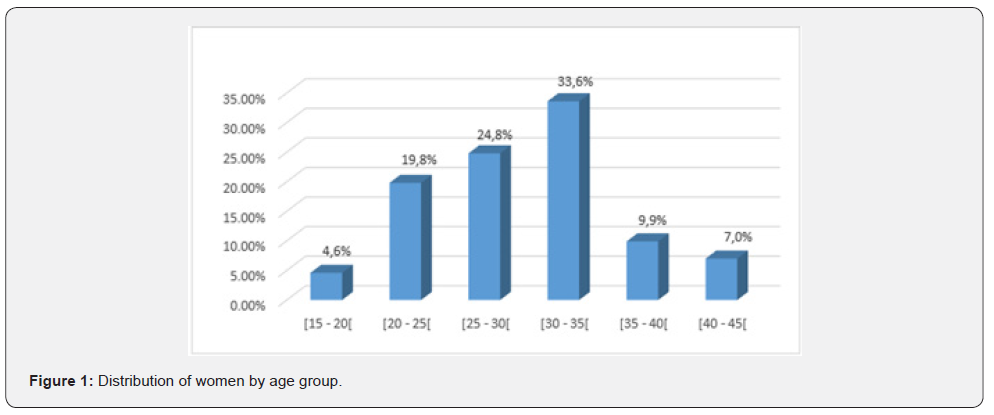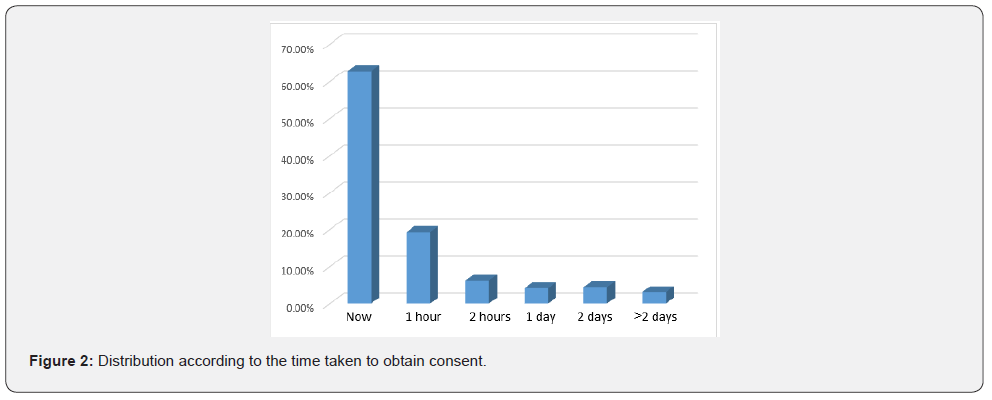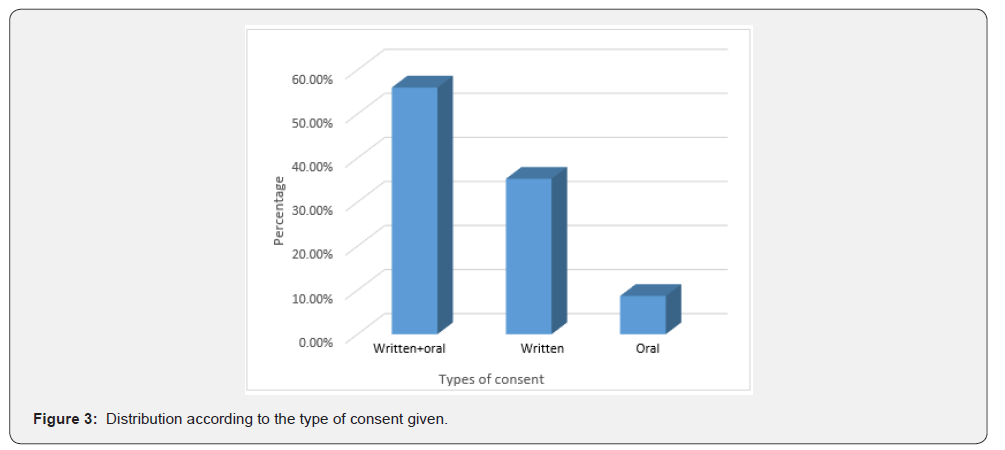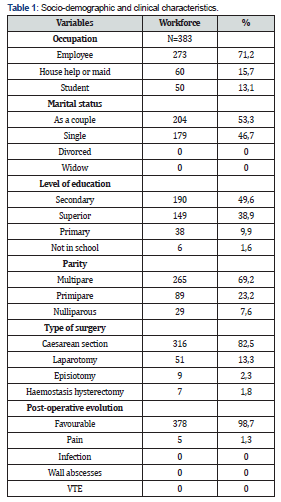Prevalence of Consent in Obstetric Surgery in a Tertiary Hospital of Cameroon
Eric Nseme Etouckey1*, Junie Annick Metogo Ntsama2, David Gaba2, Wilfried Loic Tatsipie2 and Veronique Sophie Mboua Batoum2
1 Department of Morphological Sciences and Anatomopathological, University of Yaoundé I, Cameroon
2 Department of Gynaecology-Obstetrics, University of Yaoundé I, Cameroon
Submission:March 04, 2022;Published:March 22, 2022
*Corresponding author: Eric Nseme Etouckey, Department of Morphological Sciences and Anatomopathological, University of Yaoundé I, Cameroon J
How to cite this article: Eric Nseme Etouckey, Junie Annick Metogo Ntsama, David Gaba, Wilfried Loic Tatsipie and Veronique Sophie Mboua Batoum. Prevalence of Consent in Obstetric Surgery in a Tertiary Hospital of Cameroon. J Forensic Sci & Criminal Inves. 2022; 15(4): 555920. DOI: 10.19080/JFSCI.2022.15.555920.
Summary
Introduction: Consent is the express agreement to a choice, offer, or request. In gynaecological surgical practice, this act has changed the paternalistic approach to the doctor-patient relationship, in which the patient submitted to the doctor's decisions, to one of shared decision-making.
Objective: To determine the prevalence of consent in obstetric surgery at the maternity ward of the Gynaecological-Obstetric and Paediatric Hospital in Yaoundé.
Methodology: A cross-sectional and prospective study was conducted at the Yaoundé Gynaecological-Obstetric and Paediatric Hospital from November 2020 to June 2021, i.e., a duration of 8 months. All women who underwent surgery in pregnancy at the Yaoundé Gynaecological-Obstetric and Paediatric Hospital and who gave their informed consent were included in our research. Data collection was done using a pre-designed form and then analysed using SPSS version 25.0 software.
Results: The mean age of our patients was 29.3±5.9 years with extremes ranging from 16 to 44 years. The majority were married (53.3%), with at least secondary education (88.5%). The overall prevalence of consent for obstetric surgery was 93.2%. In 88.2% of cases, consent was given on the day of the operation, in oral form and in written form in 56%.
Conclusion: The prevalence of consent in obstetric surgery at the maternity ward of the Yaoundé Gynaecological-Obstetric and Paediatric Hospital is very high.
Keywords: Consent; Prevalence; Obstetric Surgery; Gynaecological-Obstetric; Oral Forms; Multiparous Women; Multiparous Adults; Socio-Demographic; Medical Ethics; Elective Surgery
Introduction
The patient's right to make decisions about his or her own health care has been enshrined in legal and ethical statements worldwide [1]. Consent is defined as the willingness to commit one's person or property or both. One commits the property of others when acting in execution of a mandate, also known as "power of attorney", issued by the proxy [2]. Informed consent is therefore the act of expressly agreeing to a choice, an offer, or a request after having received clear, fair, and appropriate information. It is one of the essential notions of current medical ethics. In Cameroon, the application of this requirement in care motivated this research on the prevalence of consent in obstetric surgery at the maternity ward of the Gynaecological-Obstetric and Paediatric Hospital in Yaoundé.
Methodology
This was a cross-sectional and prospective study that was conducted from November 2020 to June 2021, i.e., a duration of 8 months, at the maternity ward of the Yaoundé Gynaecological-Obstetric and Paediatric Hospital. Women operated on during pregnancy who had given their informed consent were included. They were seen in the hospital ward in the postoperative period. Data collection was done using a pre-designed form and then analysed using SPSS version 25.0 software. The results were reported as means ± standard deviation, frequencies, and percentages.
Results




A total of 383 patients were included in our study. The mean age was 29.3±5.9 years with extremes ranging from 16 to 44 years. The most represented age group was 30 to 35 years with 129 individuals, i.e., 33.6%. The majority (53.3%) were married, with a secondary (49.6%) and higher (38.9%) level of education (Figure 1). Married women were the most represented (53.3%), the most common levels of education were secondary (49.6%) and higher (38.9%). Most of our patients were employed (71.2%). The most frequent type of surgery was caesarean section (82.5%), and the postoperative course was simple for almost all patients (98.7%) (Table I). The majority (88.2%) declared that they had given their consent on the day of the operation, including 62.7% immediately before their admission to the operating theater. Only 11.8% had given written consent at least one day before the operation (Figure 2). The most common type of consent found was a combination of written and oral forms in 56,0% followed by the written form in 35.3% as shown in Figure 3.
Discussion
Socio-demographic profile
The average age of our patients, 29.3±5.9 years, was close to the average age found by Coulibaly et al. [3]. The most represented age group was between 30 and 35 years (33.6%) and differed from that found by Teshome et al which was 25 to 30 years [4]. This could correspond to the period of intense genital activity of the woman during which the gyneco-obstetrical history accumulates. Multiparous women with an obstetrical history were in the majority with a rate of 69.2%, which justified the use of surgery. The most common type of surgery was caesarean section (82.5%) and was like the findings of Zeeshan et al. [5].
Prevalence of consent
The prevalence of consent in obstetric surgery at the Yaoundé Gynaecological-Obstetric and Paediatric Hospital, i.e93. .2%, is superimposed on those of Robertson et al in Australia (98%) [6], Ochieng et al. [7] in Uganda (92.9%) and Osimé et al. [8] in Benin. This could be justified by the exemplary nature of university hospitals vis-à-vis other structures of lower categories. Coulibaly et al in Mali in 2019 [3] reported a prevalence of 29.3% for consent to episiotomy, which could be explained by the fact that as episiotomy is performed during delivery, many women were not able to give consent.
Conclusion
Most women were young, multiparous adults with at least secondary education. The prevalence of consent in obstetric surgery at the Yaoundé Gynaecological-Obstetric and Paediatric Hospital was very high. Consent was obtained for emergency and elective surgery and is part of the surgical checklist. Most of the women had given their consent on the day of the operation in oral and written form.
Acknowledgements
The authors received no financial support for the research, authorship, and publication of this article.
References
- Laplaud A (2019) Consent and medical liability, University of Limoges, French.
- Braudo Serge (2020) Dictionary of French private law.
- Coulibaly M, Thera J, Samake S, Traore A, Keita S, et al. (2019) Consent to episiotomy about 331 cases at the reference health centre of the district of Bamako. Mali méd 34(2): 40-44.
- Teshome M, Zenebe W, Gedefaw A, Tariku M, Anteneh A (2018) Surgical informed consent in obstetric and gynecologic surgeries: experience from a comprehensive teaching hospital in Southern Ethiopia. BMC Medical Ethics 19: 1-9.
- Zeeshan M, Yousufi Z, Khan D, Malik R, Hira T, et al. (2019) Informed consent practice for obstetric and gynaecologic procedures: A patients' perspective from a developing country. J Eval Clin Pract 25(3): 1-7.
- Robertson G, Verco J (2013) The Quality of Consent - What is the Evidence? Australian and New Zealand Journal of Obstetrics and Gynaecology 53(5): 502-504.
- Ochieng J, Buwembo W, Munabi I, Ibingira C, Haruna K, et al. (2015) Informed consent in clinical practice: patients' experiences and perspectives following surgery. BMC Res Notes 8(765): 1- 6.
- Osime C, Okojie O, Osadolor F, Mohammed S (2004) Current practices and medico-legal aspects of pre-operative consent. East African Med Journ 81(7): 331-335.






























